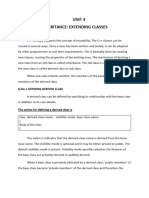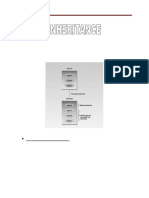0 ratings0% found this document useful (0 votes)
4 viewsChapter No-03.Extending Classes Using Inheritance
The document discusses inheritance in object-oriented programming, explaining the concept of derived classes and the visibility modes (private, protected, public) that affect member access. It outlines different types of inheritance including single, multiple, hierarchical, multilevel, and hybrid inheritance, along with examples in C++. Additionally, it touches on the concept of virtual base classes to avoid duplication of inherited members in hybrid inheritance scenarios.
Uploaded by
vrushalikabade36Copyright
© © All Rights Reserved
We take content rights seriously. If you suspect this is your content, claim it here.
Available Formats
Download as PDF or read online on Scribd
0 ratings0% found this document useful (0 votes)
4 viewsChapter No-03.Extending Classes Using Inheritance
The document discusses inheritance in object-oriented programming, explaining the concept of derived classes and the visibility modes (private, protected, public) that affect member access. It outlines different types of inheritance including single, multiple, hierarchical, multilevel, and hybrid inheritance, along with examples in C++. Additionally, it touches on the concept of virtual base classes to avoid duplication of inherited members in hybrid inheritance scenarios.
Uploaded by
vrushalikabade36Copyright
© © All Rights Reserved
We take content rights seriously. If you suspect this is your content, claim it here.
Available Formats
Download as PDF or read online on Scribd
You are on page 1/ 18
fe O Chaplee No-3
Extending classes USi
~ Capa of dass te Fa
_land chaeadea{sticS from anothet
1
A ]__base class fsapet
ass +
[ patent el
Ee + - a Peeived dass [sub day”
E ; ie [chides
[Define _Detived class - ? i
The class whith Inheeites {he membee of
anotheé class }S cated as devived class
@ scanned with OKEN Scanner
felusy Aeviyed lass pune /oiblilyinede hyse day
} name
body of derpved elnes
le ;
|
Heliieny frigdes
The nisihy modes spaifies auhelhee® [he feahaees
Bh the base classy ope pabtlenty dohedted,
ae Velysbebe Teheeibed “14 can ie Pobive
oP pelyte
4 lal
agg pp
5 | |
Vabiie
yoid dleplay
|
|
'
|
|
a
logs B Public
: Mbiig 1
wig | nyew ©)
1
4
a when metre defining Theohed So
thal obgee fary access foth dass
ll
@ scanned with OKEN Scanner
Q E
State and explain the visibility modes used in inheritance.
Visibility mo
© private
© protected
public
Base class Derived class visibility _ -
vistilty [Protected | Public
Not Not Not
Inherited | Inherited _| Inherited.
Protected | Private | Protected ected -
Public | Private | Protected _| 1
+ Privates
© When a base class is privately inherited by a detived class,
‘public members" and ‘protected members’ of the base class
become ‘private members’ of the derived lass.
© Therefore, the public andl protected members of the base class
can only be accessed by the member functions of derived class |
bout, cannot be accessed by the objects of the derived class, | aan ~
Syntax: |
class derived: private hase |
{ |
JiMembers of derived class;
}e Public: —— =
| 0 When aba ublicly inherited by a derived class then
| ‘Protected members’ of base class becomes. ‘protected
| members’ and ‘public members" of the base class become
‘public members” of the derived elass,
© Therefore the public members of the base class can be | ———
‘uecessed by both the member functions of derived class as well
4s the objects of the derived cla:
Syntax:
class derived: public base
{
“Members of derived elass;
hk
© Protected:
© When a base class is protetedly inherited by a derived cass,
‘Public and protected members’ of the base class become
‘protected members’ of the derived class,
© Therefore the pul
can be accessed by the member functions of derived clase ag
Well as the member functions of immediate derived class of it
but they cannot be accessed by the objects of derived clase
Symtac:
lass derived: protected base
{
“Members of derived class;
K
@ scanned with OKEN Scanner
Pints,
pe
6 | Sompre Program .
Gindude CFostream hy
painciude éconto. hy
_clasS Sempre 4
Pubic:
Veid dispey ¢ y
Coup <
Ob: disriory cy
~“gedehoos 2 oo en
@ scanned with OKEN Scanner
Tpratifie Takeelianre
class whith Contains mote then bo s¢ Class
jondonly one detived class | cus muskiPle
cy inheettaunce -
rien : i oo
Lelass bose t a
3 ‘ = = _
- " Membet of dass base L areas
Jeloss paseo i sane a
7 Mmembet Of dassbayo aT
ss deeived + pub
@ scanned with OKEN Scanner
Pe —" co
ay Mowing
THREE of the fol —s |
pt any sram to implement inheritance shown in
Atte!
write # CH prog!
followin figure: ; ;
8 Ties Teacher | | Class
Ans_| #include
class Teacher
{
protected:
char Name[20];
int empid;
B
class Student
a {
protected:
char sname[20]; a
int rollno;
}; -
a Info:public Teacher,public Student a
public:
void acceptT()
u
Ps
cout<<"\nEnter data for teacher:"':
cout<<"\nName:"; ,
cin>>Name;
cout<<"\nEmployee id:"; !
cin>>empid; :
@ scanned with OKEN Scanner
void displayT()
:
t .
cout<<"\nTeacher's data is:";
cout<<"\nName:"<>sname:
cout<<"\nRoll no:";
cin>>rollno;
}
void displayS()
{
cout<<"\nStudent's data is:";
cout<<"\nName:"<
using namespace std;
classA //superclass A
public:
void show A() {
cout<<"class A"< W
| P
PB
a ;
c
a }}
}
——~ consider @ hybrid inheritance as shown in the above diagram. The |
itd class has two direct base classes, Parent! and Parent which ‘
themselves have a common base class as Grandparent. The child 7
——— inherits the members of Grandparent via two separate paths, All the | ©
public and protected members of Grandparent are inherited into Child 7
— rice, first via Parent] and again via Parent2. This leads to duplicate \c
fois ofthe inherited members of Grandparent inside Child class. The 7
——~ Guplication of inherited members can be avoided by making the ¢
common base class as virtual base class while declaring the direct or £
intermediate base classes as shown below. 4
—— class Grandparent :
peat
class Parent! virtual public Grandparent ;
{
—h
class Parent2:virtual public Grandparent
— {
b
—— class Child: public Parent! public Parent
B
“|
| Example
oa Hinclude
| #include
~| am student
—lulmo;
ae sea :
@ scanned with OKEN Scanner
| publ
void getnumber()
|
\4
| cout<<"Enter Roll No:",
| cin>>mo;
¢
\}
| void putnumber()
if
c
| cout<<"inint Roll No:"<>partl; cout<<"Part2:";
cin>>part2;
ly
14
ie
|
void putmarks()
{
cout<<"\t Marks Obtained\n";
cout<<"\n\t Part] :"<>score;
}
void putscor
@ scanned with OKEN Scanner
S
cout<<"\n\t Sports Score is:"<. poe
ois a
eat xc ST arn bo secia
2 hoe?
a b sii 33
Ay ob: Show)
yo Sf OO _
e geno,
er
Se
—Bypek ————
ee
® scanned with OKEN Scanner
You might also like
- Chapter - 6 Inheritance CBSE CLASS 2019-20 C++ NOTES (OLD)No ratings yetChapter - 6 Inheritance CBSE CLASS 2019-20 C++ NOTES (OLD)14 pages
- chapter 3_inheritance_extending classes1No ratings yetchapter 3_inheritance_extending classes113 pages
- 14 Inheritance Extending Classes: L L L L LNo ratings yet14 Inheritance Extending Classes: L L L L L15 pages
- 21CSC101T: Object Oriented Design and Programming UNIT-3No ratings yet21CSC101T: Object Oriented Design and Programming UNIT-3147 pages
- INHERITANCE - Object-Oriented ProgrammingNo ratings yetINHERITANCE - Object-Oriented Programming14 pages
- Chapter No-02. Functions and Constructors.No ratings yetChapter No-02. Functions and Constructors.27 pages
































































